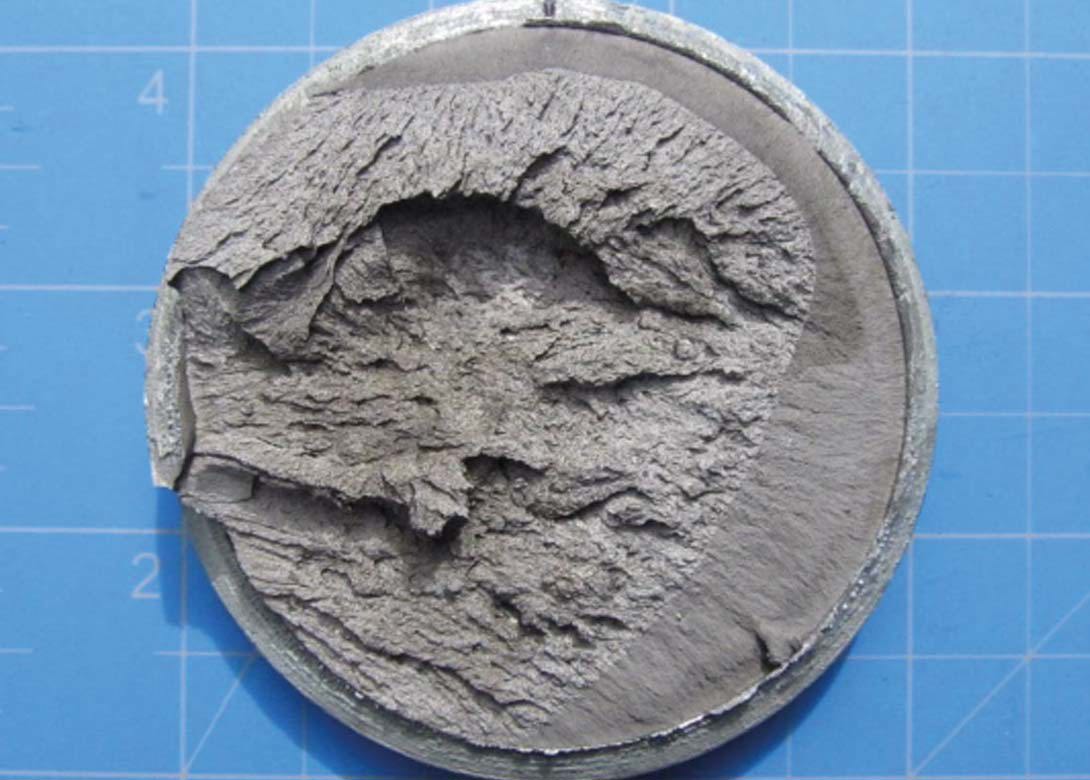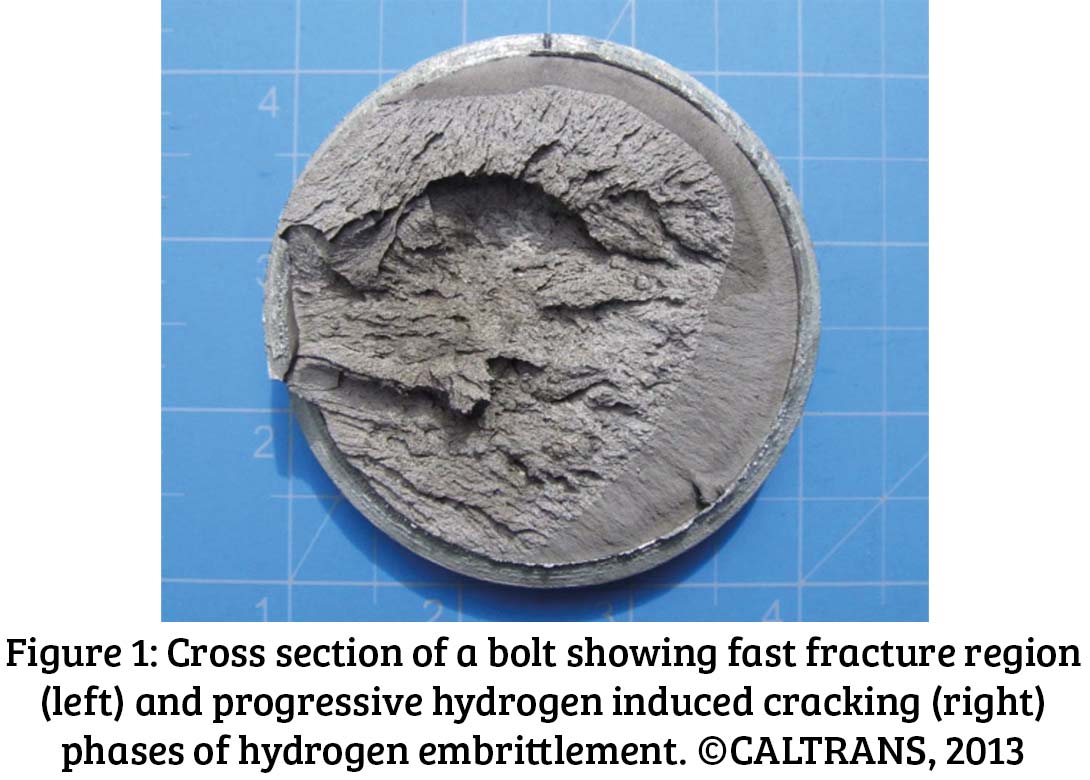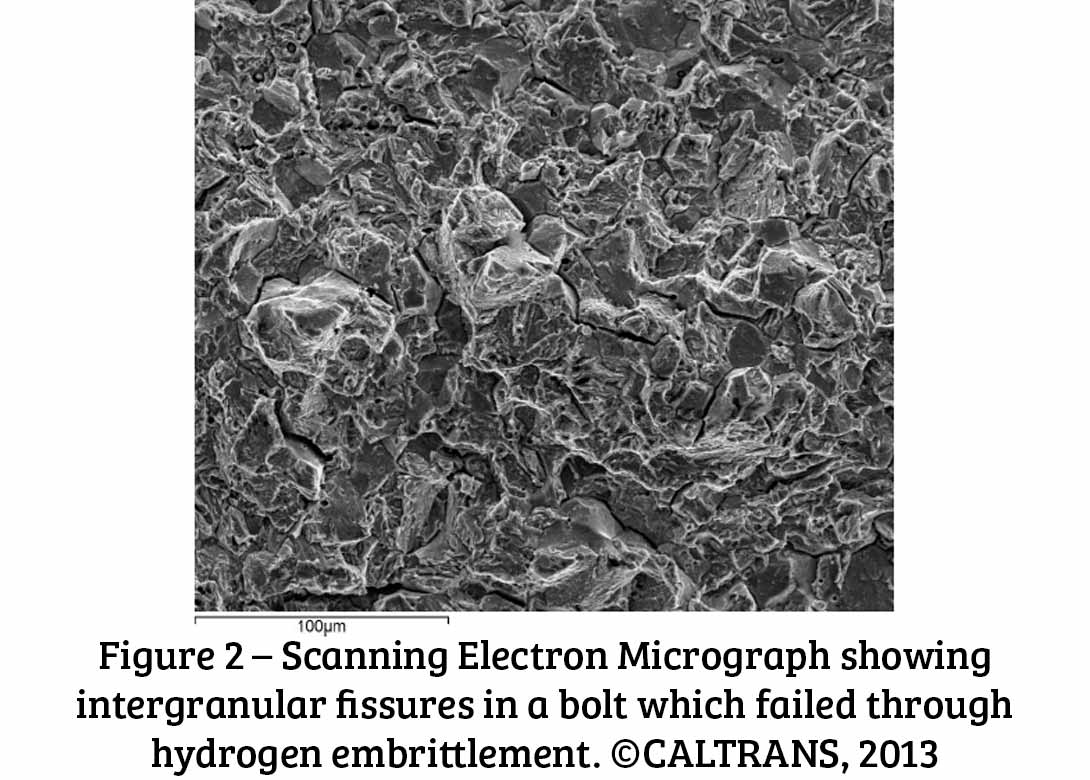
By Ryan Murphy, technical director, Evolution Fasteners (UK) Ltd
The march of time thrusts forward and in doing so there is continual development of product standards and manufacturing processes. Quite simply, the construction industry demands more performance from products today than was ever done before – at a cost that is as low as possible.
Bolts and anchors in particular are a victim of this march and consumers now demand higher grades for increased mechanical performance and greater corrosion protection. The danger that follows is hydrogen embrittlement.
Despite being first researched and identified in 1875 by W. H. Johnson (Johnson, 1875), the issues surrounding (and nuances therein) hydrogen embrittlement and hydrogen induced cracking are poorly understood in the construction industry. For the purposes of this article the terms hydrogen embrittlement, hydrogen induced cracking and hydrogen assisted cracking can be used synonymously.
In 2013, it was found that catastrophic failure of bolts and anchor rods had occurred on the San Francisco Bay Bridge. Thankfully, in contrast to the failures in my previous article: ‘Famous failures series: Part 1 – stress corrosion cracking’, there were no fatalities attributed to the failures. Instead the cost was an economical one; to the tune of US$25 million (Derbeken, 2013). Unfortunately for Caltrans (California Department of Transportation, the owner of the bridge), this was just one of the many controversies that befell the bridge – resulting in accumulated costs of US$86.32 million (California State Auditor, 2018).
Despite the huge economical cost and political ramifications of the San Francisco Bay Bridge failure(s), it did provoke Caltrans into undertaking a full investigation: An investigation that yielded incredible engineering insight into the underlying science of hydrogen embrittlement.
First of all, we need to understand what hydrogen embrittlement is. According to the American Society for Testing and Materials, it is the permanent loss of ductility of a metal or alloy caused by the presence of hydrogen in combination with stress (ASTM International, 2015). In Figure 1, you can see the jagged pattern left by the fissures created by hydrogen embrittlement in a failed bolt from the San Francisco Bay Bridge.

The Caltrans report touches on the fact that there are two main general apropos for the source of hydrogen embrittlement, which are termed as:
1. Internal hydrogen embrittlement
Internal hydrogen embrittlement can be caused by residual free hydrogen from the manufacturing processes involved in producing the products, for example in the steelmaking process where it was pickled and coating process where it was galvanised or electroplated (American Bridge/Fluor Enterprises Inc. 2013).
Within this genus there are various failure modes (list is not exhaustive):
- Internal pressure: Where adsorbed hydrogen species recombine to create hydrogen molecules, which in turn create pressure within the metal grain/lattice. This pressure increases to the point where the metal suffers from decreased ductility and tensile strength (Vergani, et al, 2014).
- Chemical: Formation of brittle hydrides with the parent alloy allowing crack propagation.
- Enhanced decohesion: Where the strength of the atomic bonds of the elements present in the alloy are reduced.
2. Environmental hydrogen embrittlement
Environmental hydrogen embrittlement can be caused by the external introduction of hydrogen while the bolt or anchor is under stress (Jones, 1996). Such environmental conditions can include (but are not limited to) the salinity of air or water vapour, leachates, admixtures, effluent or acidity of rainwater (Gangloff, 1986).
In both geneses, there is an unholy trinity of combining ingredients that come together to cause hydrogen embrittlement:
- Susceptibility: The material itself must be susceptible to hydrogen embrittlement either by its metallurgy or mechanical properties (or both).
- Stress: The material has to be under a tensile load high enough to cause hydrogen embrittlement.
- Hydrogen: From the aforementioned internal or environmental sources. Now, we have to dive deeper into each of these ingredients and explore the conditions of each.
Susceptibility
From the engineering perspective, material strength has a first order effect on susceptibility to hydrogen embrittlement (as strength increases, steels become less ductile and less tough). At equal strength, steel that has lower toughness is inherently more brittle and more susceptible to hydrogen embrittlement. Research by Caltrans found that the susceptibility of the steel increases significantly when the hardness of the steel exceeds 39 HRC (American Bridge/ Fluor Enterprises Inc, 2013) and this coincides with the findings of other researchers (Brahimi, 2014).
Stress
The very nature of mechanical fasteners in their normal service conditions means they are subject to tensile load (stress being the force applied on a body distributed per unit area of that body). The research conducted by Caltrans found that susceptibility increased significantly once fasteners were loaded beyond 75% of their ultimate tensile strength (American Bridge/ Fluor Enterprises Inc, 2013). In the event the other two conditions are met, then quite simply, the higher the level of stress; the higher the susceptibility to hydrogen embrittlement.
Hydrogen
We briefly touched on the two geneses of internal hydrogen and environmental hydrogen earlier in this article. The principle source of residual hydrogen inside the material is in reversible trap sites with high bonding energies where hydrogen is released into the material through galvanising or plating in the up-quench (thermal shock) experienced upon immersion on the molten zinc (Brahimi, 2014). The hydrogen then accumulates at grain boundaries.
The amount of hydrogen adsorbed from environmental sources is totally dependent on the source itself as well as the condition and type of coating on the fasteners (as well as the condition of the coating). In the case of fasteners being used in steel sections, which are also galvanised, the galvanic corrosion of the sacrificial zinc coating on the steel generates hydrogen and since the steel is the cathode it is readily adsorbed into the grain (The National Academies of Sciences, Engineering and Medicine, 2018).
The end result is hydrogen embrittlement, which is characterised by intergranular fracture between the grains of the steel, this is clearly seen under high magnifications in a scanning electron microscope, as shown in Figure 2.

Now that we understand the phenomenon of hydrogen embrittlement, what can we do to mitigate or remove it from fasteners? The answer is not easy and is dependent on the fastener type, the materials the fasteners are made from, the coating applied to the fasteners and the environmental conditions the fasteners are subjected.
Ideally coatings that produce a lot of hydrogen as part of their industrial process, or evolve hydrogen in their chemical reactions, should be avoided such as electroplating (cadmium, nickel or zinc), galvanising or titanium nitriding in lieu of techniques that either produce less evolved hydrogen or allow evolved hydrogen to escape (i.e. are not barriers to diffusion of the hydrogen) such as organic dip-spin coatings or oxide conversions (Bhadeshia, 2016), as such coatings allow the product to be baked in ovens to allow the diffusion of hydrogen out of the fasteners.
The other mitigating solutions are to use a fastener made of a material that is not susceptible to hydrogen embrittlement, as well as simply designing out the issue at the design stage by keeping stress to a level that allows the fasteners to remain in an elastic state.
References
- American Bridge/ Fluor Enterprises, Inc., 2013. Metallurgical analysis of bay bridge broken anchor rods S1-G1 and S2-A6, San Francisco: California Department of Transportation.
- ASTM International, 2015. Standard terminology relating to hydrogen embrittlement testing. West Conshohocken (Pennsylvania): American Society of Testing and Materials.
- Bhadeshia, H. K. D. H., 2016. Prevention of hydrogen embrittlement in steels. Iron and Steel Institute of Japan, Issue 56, pp. 24-36.
- Brahimi, S., 2014. Fundamentals of hydrogen embrittlement in steel fasteners. 1st ed. Montreal: IBECA Technologies Corp..
- California State Auditor, 2018. Toll bridge seismic retrofit program, Sacramento: Government of California.
- Derbeken, J. v., 2013. Bay Bridge fix in place, $25 million later. [Online] Available at: https://www.sfgate.com/default/article/Bay-Bridge-fix-in-place-25-million-later-5076643.php
- Gangloff, R. P., 1986. A review and analysis of the threshold for hydrogen environment embrittlement of steel. Watertown, United States Army Materials Technology Laboratory.
- Johnson, W. H., 1875. On some remarkable changes produced in iron and steel by the action of hydrogen and acids. London, The Royal Society Publishing , pp. 168-179.
- Jones, D. A., 1996. Principles and prevention of corrosion. 2nd ed. Upper Saddle River: Prentice Hall.
- The National Academies of Sciences, Engineering and Medicine, 2018. High-performance bolting technology for offshore oil and natural gas operations. 1st ed. Washington DC: The National Academies Press.
- Vergani, L. et al., 2014. Hydrogen effect on fatigue behaviour of a quenched and tempered steel. Procedia Engineering, Volume 74, pp. 468-471.

Will joined Fastener + Fixing Magazine in 2007 and over the last 12 years has experienced every facet of the fastener sector – interviewing key figures within the industry and visiting leading companies and exhibitions around the globe. Will manages the content strategy across all platforms and is the guardian for the high editorial standards that the brand is renowned.






